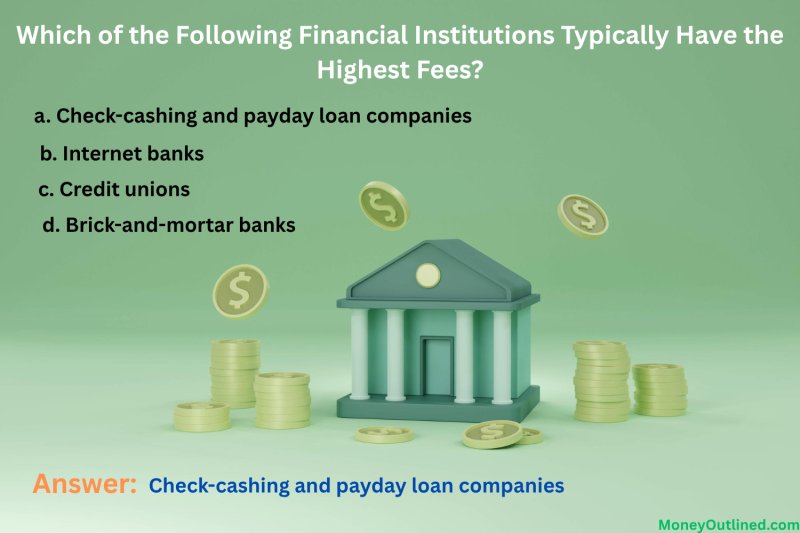
Credit card companies and payday lenders typically have the highest fees among financial institutions. These fees can quickly add up, impacting your financial well-being. Understanding which of the following financial institutions typically have the highest fees is crucial for making informed decisions about your money. Let’s explore how to navigate these costs and safeguard your finances.
Which of the Following Financial Institutions Typically Have the Highest Fees?
Welcome to our comprehensive guide on understanding which financial institutions tend to have the highest fees. Managing your finances is an essential aspect of adult life, and being aware of potential fees can help you make informed decisions. In this article, we will delve into the world of financial institutions and explore where you might encounter higher fees. Let’s get started!
Overview of Financial Institutions
Before we jump into discussing fees, let’s first understand what financial institutions are. Financial institutions are organizations that provide various financial services to individuals and businesses. These institutions play a crucial role in the economy by facilitating transactions, offering loans, and managing investments.
Types of Financial Institutions
There are several types of financial institutions, each serving different purposes. Some common types include:
1. Banks
Banks are perhaps the most well-known type of financial institution. They offer services such as checking and savings accounts, loans, and credit cards. Banks can be further categorized into commercial banks, online banks, and credit unions.
2. Credit Unions
Credit unions are member-owned financial cooperatives that provide similar services to traditional banks. One key difference is that credit unions are typically more community-focused and may offer lower fees and better interest rates to their members.
3. Brokerage Firms
Brokerage firms specialize in managing investments on behalf of clients. They facilitate buying and selling stocks, bonds, and other securities. Brokerage firms may charge fees for their services, such as transaction fees and advisory fees.
4. Online Payment Platforms
Online payment platforms like PayPal, Venmo, and Cash App have gained popularity for their convenience in sending and receiving money. While these platforms may offer low-cost or free transactions for personal use, they can have fees for certain services, such as instant transfers.
Factors Influencing Fee Structures
Now that we have an understanding of the types of financial institutions, let’s explore the factors that can influence fee structures:
1. Operational Costs
Financial institutions incur various operational costs, such as rent, employee salaries, and technology expenses. Institutions with higher overhead costs may pass on these expenses to customers in the form of fees.
2. Services Offered
The types of services offered by a financial institution can also impact fee structures. Institutions that provide specialized services or personalized financial advice may charge higher fees to cover the additional value they offer.
3. Membership Status
Some financial institutions, such as credit unions, operate on a membership basis. Members of these institutions may benefit from lower fees and better interest rates compared to non-members. Membership status can influence the fee structure you encounter.
Financial Institutions with Highest Fees
After considering the different types of financial institutions and the factors that can affect fee structures, it’s important to note that certain institutions tend to have higher fees compared to others. Let’s explore some of these institutions:
1. Investment Banks
Investment banks cater to high-net-worth individuals and institutional clients. These banks offer services such as mergers and acquisitions, underwriting, and trading. Investment banks are known for charging substantial fees for their specialized services.
2. Private Wealth Management Firms
Private wealth management firms provide personalized investment and financial planning services to affluent clients. Due to the tailored nature of their services and the expertise they offer, these firms typically have higher fees compared to traditional banks.
3. Specialist Financial Advisors
Specialist financial advisors, such as those who focus on estate planning or tax optimization, may charge higher fees for their specialized knowledge and services. Clients seeking advanced financial advice may encounter higher fees when working with these professionals.
4. International Banks
International banks that cater to clients with global financial needs may have higher fees due to the complexity of cross-border transactions, currency exchange, and compliance requirements. Clients engaging in international banking may encounter fees for these specialized services.
How to Avoid High Fees
While certain financial institutions may have higher fees, there are strategies you can use to minimize costs and make the most of your finances:
1. Comparison Shopping
Before committing to a financial institution, compare fees across different options. Look for institutions that offer competitive rates and low fees for the services you need.
2. Consider Credit Unions
Joining a credit union can be a cost-effective alternative to traditional banks, as credit unions often offer lower fees and better interest rates to their members.
3. Negotiate with Your Bank
If you have a longstanding relationship with your bank, consider negotiating fees or asking for fee waivers. Some institutions may be willing to work with you to retain your business.
4. Monitor Your Accounts
Stay vigilant about monitoring your accounts for any unexpected fees or charges. By regularly reviewing your statements, you can catch any discrepancies and address them promptly.
Understanding which financial institutions typically have the highest fees is a crucial step in managing your finances effectively. By being informed about fee structures, factors influencing fees, and strategies to minimize costs, you can make smart financial decisions that align with your goals. Remember to assess your financial needs and consider the trade-offs between fees and services when selecting a financial institution. With a proactive approach to managing fees, you can navigate the financial landscape with confidence and control.
We hope this guide has provided you with valuable insights into the world of financial institutions and fee structures. If you have any questions or would like further information, feel free to reach out to us. Thank you for reading!
Which of the following financial institutions typically have the highest fees?
Frequently Asked Questions
What factors determine the fees charged by financial institutions?
The fees charged by financial institutions can vary based on factors such as the type of services offered, account balance requirements, transaction volume, and location. Institutions may also have different fee structures based on their business models.
Do traditional brick-and-mortar banks typically have higher fees compared to online banks?
Generally, traditional brick-and-mortar banks often have higher fees than online banks. Online banks have lower operating costs as they do not have physical branches, allowing them to offer lower fees and sometimes even fee-free accounts.
Are credit unions known for charging lower fees compared to commercial banks?
Yes, credit unions are known for typically charging lower fees compared to commercial banks. Credit unions are not-for-profit organizations owned by their members, which can result in lower fees and better interest rates on savings accounts and loans.
Final Thoughts
Credit unions and online banks generally offer lower fees compared to traditional banks. However, among the following financial institutions, traditional banks typically have the highest fees due to their extensive physical presence and higher operating costs. When considering where to bank, it’s essential to weigh the fees and services offered by different institutions. Be sure to assess your needs and preferences to choose the best fit for your financial goals.





